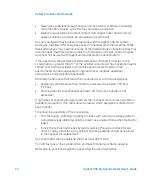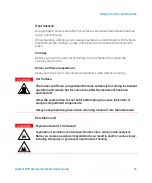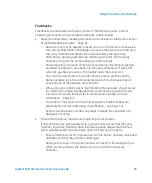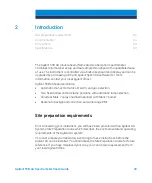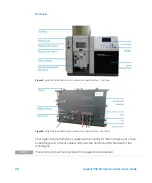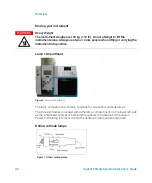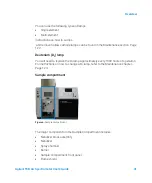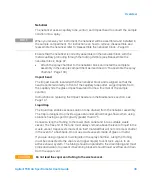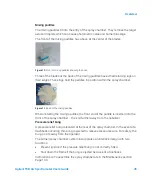
Safety Practices and Hazards
30
Agilent 55B AA Spectrometer User’s Guide
Damage to O-rings in the nebulizer can allow leakage of the oxidant which
can reduce the total flow of gas through the burner slot and so increase
the possibility of a flashback occurring.
Any cracked or deformed O-rings must be replaced immediately.
The liquid trap must be filled with the same solution as the matrix used for
the standards and samples.
A drain tube must be attached to the lower nipple of the liquid trap. The
tube must slope downwards all the way to the drain vessel so that the
waste liquid drains smoothly.
The end of the drain tube must not be allowed to drop below the expected
level of the liquid in the vessel. This can cause the liquid to backflow and
cause flashback.
When using organic or toxic liquids in the spray chamber, a vent tube
must be attached to the upper vent nipple of the liquid trap. It must slope
downwards (running parallel to the drain tube) to prevent it becoming
blocked should any liquid drain out. The tube must be vented to an active
exhaust system.
All of the above points must be observed because a sudden surge of
waste liquid can affect the pressure in the spray chamber and result in a
flashback.
Observe the recommendations concerning the use of Acetylene– see
Page 15.
Free acetylene is unstable at elevated pressures and must be stored in the
cylinder by dissolving it in acetone.
If the gas is withdrawn too quickly, or the cylinder pressure drops below
700 kPa, acetone may be drawn off in sufficient quantities to affect
analytical performance, damage seals, O-rings and hoses, or even cause a
flashback.
Perchloric acid is well known for forming unstable salts. Operators using
this acid should ensure that the minimum amount can reach the
spectrometer, and that the burner, spray chamber and liquid trap are
thoroughly cleaned after each analysis to ensure that unstable salts are
not allowed to build up.
Failure to do this can result in unpredictable flashbacks.

